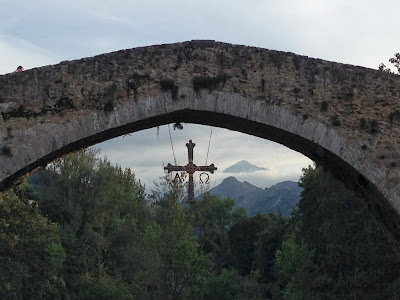The proud
town of Cangas de Onís is one whose name is familiar for everybody in Spain.
Not far from
here happened one of the most important moment in Spain’s history, when Don
Pelayo held back the advancing troops of the muslims around 722. The people of
Asturias were so happy that they quickly crowned him and in turn he made Cangas
de Onís the capital of Spain where the ‘reconquista’ started. It was only a
capital for about 40 years but no Asturian can forget the prestige of that
short time.
Nowadays the
town, apart from its history, is better known by its location. It lies only a
few kilometres away from Asturias’ highest mountains, the Picos de Europa and
the Natural Park that was named after them. It lies in a valley that was formed
by two rivers and is one of the two main gateways to the Natural Park. It
retained little from its former glory and today the main street is lined
endlessly with souvenir shops however there are a few points of (my) interest.
The Roman Bridge of Cangas de Onís
This bridge
is the most distinctive feature of the town and one of the most well-known
symbols of the whole region of Asturias. It dates back to the end of the 13th
century, has a Romanesque style and the Victory Cross hangs from its highest
arch (in a reproduction form, of course).
The statue of Don Pelayo
He’s the
hero whose name is all around Asturias, from cafes to street names, everywhere.
I simply had to take a photo of this amazing celebrity. If you can’t see him
‘in person’, fear not, the small reproduction of this statue can be bought from
any souvenir shop in the region.
La Capilla
de la Santa Cruz
The Chapel
of the Saint Cross was founded by Favila, the daughter of the above mentioned
Don Pelayo. The church was dedicated to the holding of the Saint Cross, the
same one that her daddy was holding while beating up the moors and the one that
later become the Cross of Victory (read more about the legend here).
The blog
would not be whole without mentioning the village of Covadonga. This is the
place where the famous battle took place and where the remains of King Pelayo
are kept. It is only a few kilometres away from Cangas and the other gateway to
the National Park. We didn’t have the time to look around much, however the
Covadonga Cathedral demanded our attention. It was built on a large terrace
high above the line of the trees in such a place that the sun lights it up when
it rises and also when it goes down.
















No comments:
Post a Comment